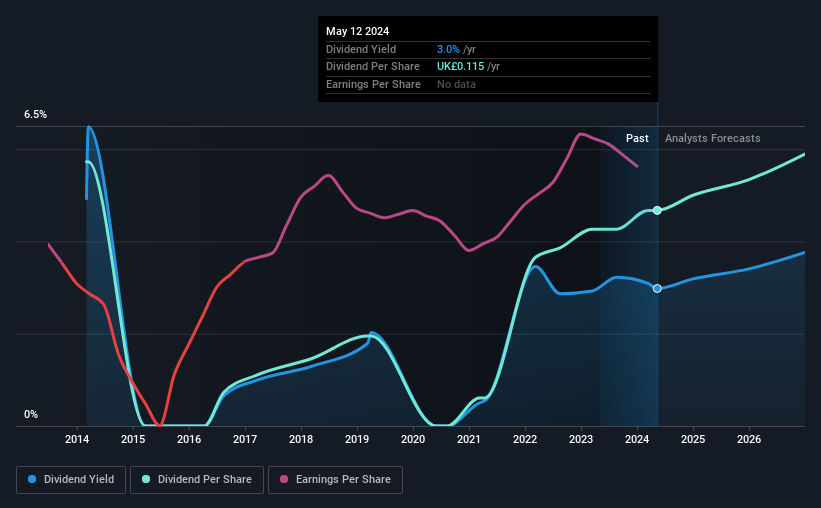Balfour Beatty plc (LON:BBY) Looks Like A Good Stock, And It's Going Ex-Dividend Soon
Balfour Beatty plc (LON:BBY) is about to trade ex-dividend in the next three days. The ex-dividend date is one business day before the record date, which is the cut-off date for shareholders to be present on the company's books to be eligible for a dividend payment. The ex-dividend date is important because any transaction on a stock needs to have been settled before the record date in order to be eligible for a dividend. Thus, you can purchase Balfour Beatty's shares before the 16th of May in order to receive the dividend, which the company will pay on the 3rd of July.
The company's next dividend payment will be UK£0.08 per share, on the back of last year when the company paid a total of UK£0.12 to shareholders. Looking at the last 12 months of distributions, Balfour Beatty has a trailing yield of approximately 3.0% on its current stock price of UK£3.86. Dividends are an important source of income to many shareholders, but the health of the business is crucial to maintaining those dividends. So we need to investigate whether Balfour Beatty can afford its dividend, and if the dividend could grow.
Check out our latest analysis for Balfour Beatty
Dividends are usually paid out of company profits, so if a company pays out more than it earned then its dividend is usually at greater risk of being cut. That's why it's good to see Balfour Beatty paying out a modest 33% of its earnings. A useful secondary check can be to evaluate whether Balfour Beatty generated enough free cash flow to afford its dividend. Thankfully its dividend payments took up just 31% of the free cash flow it generated, which is a comfortable payout ratio.
It's positive to see that Balfour Beatty's dividend is covered by both profits and cash flow, since this is generally a sign that the dividend is sustainable, and a lower payout ratio usually suggests a greater margin of safety before the dividend gets cut.
Click here to see the company's payout ratio, plus analyst estimates of its future dividends.
Have Earnings And Dividends Been Growing?
Companies with consistently growing earnings per share generally make the best dividend stocks, as they usually find it easier to grow dividends per share. If earnings decline and the company is forced to cut its dividend, investors could watch the value of their investment go up in smoke. For this reason, we're glad to see Balfour Beatty's earnings per share have risen 14% per annum over the last five years. Earnings per share have been growing rapidly and the company is retaining a majority of its earnings within the business. This will make it easier to fund future growth efforts and we think this is an attractive combination - plus the dividend can always be increased later.
The main way most investors will assess a company's dividend prospects is by checking the historical rate of dividend growth. Balfour Beatty's dividend payments per share have declined at 2.0% per year on average over the past 10 years, which is uninspiring. It's unusual to see earnings per share increasing at the same time as dividends per share have been in decline. We'd hope it's because the company is reinvesting heavily in its business, but it could also suggest business is lumpy.
To Sum It Up
From a dividend perspective, should investors buy or avoid Balfour Beatty? It's great that Balfour Beatty is growing earnings per share while simultaneously paying out a low percentage of both its earnings and cash flow. It's disappointing to see the dividend has been cut at least once in the past, but as things stand now, the low payout ratio suggests a conservative approach to dividends, which we like. Overall we think this is an attractive combination and worthy of further research.
In light of that, while Balfour Beatty has an appealing dividend, it's worth knowing the risks involved with this stock. To help with this, we've discovered 2 warning signs for Balfour Beatty that you should be aware of before investing in their shares.
If you're in the market for strong dividend payers, we recommend checking our selection of top dividend stocks.
Have feedback on this article? Concerned about the content? Get in touch with us directly. Alternatively, email editorial-team (at) simplywallst.com.
This article by Simply Wall St is general in nature. We provide commentary based on historical data and analyst forecasts only using an unbiased methodology and our articles are not intended to be financial advice. It does not constitute a recommendation to buy or sell any stock, and does not take account of your objectives, or your financial situation. We aim to bring you long-term focused analysis driven by fundamental data. Note that our analysis may not factor in the latest price-sensitive company announcements or qualitative material. Simply Wall St has no position in any stocks mentioned.

 Yahoo Finance
Yahoo Finance 
